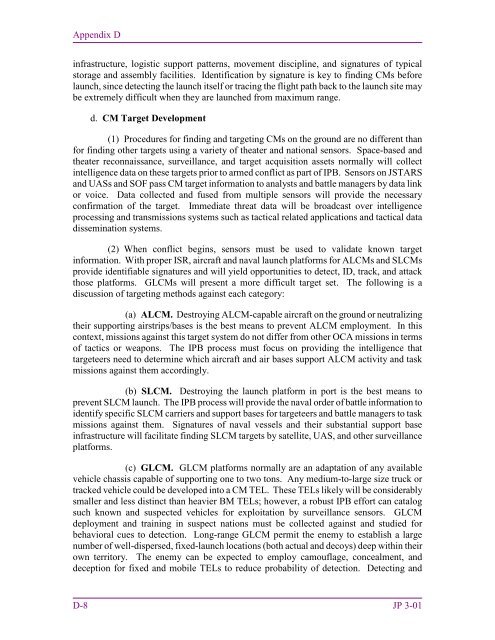JP 3-01 Countering Air and Missile Threats - Defense Innovation ...
JP 3-01 Countering Air and Missile Threats - Defense Innovation ...
JP 3-01 Countering Air and Missile Threats - Defense Innovation ...
Create successful ePaper yourself
Turn your PDF publications into a flip-book with our unique Google optimized e-Paper software.
Appendix D<br />
infrastructure, logistic support patterns, movement discipline, <strong>and</strong> signatures of typical<br />
storage <strong>and</strong> assembly facilities. Identification by signature is key to finding CMs before<br />
launch, since detecting the launch itself or tracing the flight path back to the launch site may<br />
be extremely difficult when they are launched from maximum range.<br />
d. CM Target Development<br />
(1) Procedures for finding <strong>and</strong> targeting CMs on the ground are no different than<br />
for finding other targets using a variety of theater <strong>and</strong> national sensors. Space-based <strong>and</strong><br />
theater reconnaissance, surveillance, <strong>and</strong> target acquisition assets normally will collect<br />
intelligence data on these targets prior to armed conflict as part of IPB. Sensors on JSTARS<br />
<strong>and</strong> UASs <strong>and</strong> SOF pass CM target information to analysts <strong>and</strong> battle managers by data link<br />
or voice. Data collected <strong>and</strong> fused from multiple sensors will provide the necessary<br />
confirmation of the target. Immediate threat data will be broadcast over intelligence<br />
processing <strong>and</strong> transmissions systems such as tactical related applications <strong>and</strong> tactical data<br />
dissemination systems.<br />
(2) When conflict begins, sensors must be used to validate known target<br />
information. With proper ISR, aircraft <strong>and</strong> naval launch platforms for ALCMs <strong>and</strong> SLCMs<br />
provide identifiable signatures <strong>and</strong> will yield opportunities to detect, ID, track, <strong>and</strong> attack<br />
those platforms. GLCMs will present a more difficult target set. The following is a<br />
discussion of targeting methods against each category:<br />
(a) ALCM. Destroying ALCM-capable aircraft on the ground or neutralizing<br />
their supporting airstrips/bases is the best means to prevent ALCM employment. In this<br />
context, missions against this target system do not differ from other OCA missions in terms<br />
of tactics or weapons. The IPB process must focus on providing the intelligence that<br />
targeteers need to determine which aircraft <strong>and</strong> air bases support ALCM activity <strong>and</strong> task<br />
missions against them accordingly.<br />
(b) SLCM. Destroying the launch platform in port is the best means to<br />
prevent SLCM launch. The IPB process will provide the naval order of battle information to<br />
identify specific SLCM carriers <strong>and</strong> support bases for targeteers <strong>and</strong> battle managers to task<br />
missions against them. Signatures of naval vessels <strong>and</strong> their substantial support base<br />
infrastructure will facilitate finding SLCM targets by satellite, UAS, <strong>and</strong> other surveillance<br />
platforms.<br />
(c) GLCM. GLCM platforms normally are an adaptation of any available<br />
vehicle chassis capable of supporting one to two tons. Any medium-to-large size truck or<br />
tracked vehicle could be developed into a CM TEL. These TELs likely will be considerably<br />
smaller <strong>and</strong> less distinct than heavier BM TELs; however, a robust IPB effort can catalog<br />
such known <strong>and</strong> suspected vehicles for exploitation by surveillance sensors. GLCM<br />
deployment <strong>and</strong> training in suspect nations must be collected against <strong>and</strong> studied for<br />
behavioral cues to detection. Long-range GLCM permit the enemy to establish a large<br />
number of well-dispersed, fixed-launch locations (both actual <strong>and</strong> decoys) deep within their<br />
own territory. The enemy can be expected to employ camouflage, concealment, <strong>and</strong><br />
deception for fixed <strong>and</strong> mobile TELs to reduce probability of detection. Detecting <strong>and</strong><br />
D-8 <strong>JP</strong> 3-<strong>01</strong>

















